|
|
|
Sort Order |
|
|
|
Items / Page
|
|
|
|
|
|
|
| Srl | Item |
| 1 |
ID:
190362
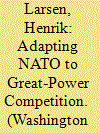

|
|
|
|
|
| Summary/Abstract |
Following Russia’s February 2022 invasion of Ukraine, NATO’s main challenge is to eliminate doubts about its strength and resolve to defend every inch of its territory, as stated in its recently published Strategic Concept, an authoritative document for the alliance’s strategic direction until 2030 (and beyond).Footnote1 By the Vilnius Summit in the summer of 2023, the alliance is set to complete the transition to a new NATO Force Model to deter Russian aggression. However, NATO’s adaptation to the military threat posed by Russia is complicated by the simultaneous need to factor in the rise of China. A rising China is stretching US military resources, and its technological clout creates vulnerabilities for a functioning defense alliance. These are vulnerabilities to which European NATO members must be especially attuned.
|
|
|
|
|
|
|
|
|
|
|
|
|
|
|
|
| 2 |
ID:
190365


|
|
|
|
|
| Summary/Abstract |
Are international politics governed by power or by principles? The February 2022 invasion of Ukraine by Russia has raised the issue of whether might makes right in today’s world, or if there is a broader set of rules and principles which states ought to abide by, even when they might not agree with them. Following the end of the Second World War, the United States and the West forged what many call a rules-based international order, in which states conduct their activities.Footnote1 During the four decades of the Cold War, this Western-led order ran up directly against a communist-led order, of which the Soviet Union and China were the chief proponents. The end of the Cold War in 1991—symbolized by the razing of the Berlin Wall two years earlier—suggested that the Western world order had won out and was therefore superior to its communist competitor. The American political scientist Francis Fukuyama put forth his well-known “end of history” thesis concerning the inevitability of Western liberal democracy and the universalization of democratic values worldwide, anchored by an American-led international order—one which is more commonly known as the liberal international order.
|
|
|
|
|
|
|
|
|
|
|
|
|
|
|
|
| 3 |
ID:
190370
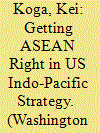

|
|
|
|
|
| Summary/Abstract |
As part of the intensifying great power competition between the United States and China, a set of new Indo-Pacific frameworks primarily led by Washington—namely the Quadrilateral Security Dialogue (Quad), the AUKUS, and the Indo-Pacific Economic Framework for Prosperity (IPEF)—has emerged. These US-centric minilateral and multilateral frameworks essentially aim to build a coalition with politically and strategically “like-minded” states to maintain and enhance the existing rules-based international order largely constructed by the West since the end of the Cold War.
|
|
|
|
|
|
|
|
|
|
|
|
|
|
|
|
| 4 |
ID:
190363


|
|
|
|
|
| Summary/Abstract |
Space capabilities are critical to the global economy, military power, and daily life. For example, the United States’ Global Positioning System enables everything from withdrawing cash from ATM machines to allowing the US military to engage in long-range precision strikes. Satellites facilitate long-distance communications, tracking and predicting weather patterns, verifying compliance with arms control treaties, detecting nuclear launches, and supplying critical Intelligence, Surveillance, and Reconnaissance (ISR) capabilities for militaries to carry out targeting. Yet with the rise of both state and private space actors, the space domain is becoming increasingly crowded and the risk of accidental collisions is increasing. At the same time, several states are pursuing counterspace weapons—raising the risks of creating highly destructive space debris and increasing the odds of accidental escalation and armed conflict in space and on Earth.
|
|
|
|
|
|
|
|
|
|
|
|
|
|
|
|
| 5 |
ID:
190368


|
|
|
|
|
| Summary/Abstract |
How should the United States respond to the China challenge? The Donald Trump administration’s 2018 National Defense Strategy predicted that “as China continues its economic and military ascendance … [it will seek] regional hegemony in the near-term and displacement of the United States to achieve global preeminence in the future.”Footnote1 Subsequently, President Joe Biden asserted in an April 2021 address to Congress that the US rivalry with China is about who will “win the 21st century.”Footnote2 Many scholars and policymakers advocate active balancing policies, including the creation of a US-led Indo-Pacific coalition system. For years, John Mearsheimer, a leading international relations theorist, has urged US leaders “to form a balancing coalition with as many of China’s neighbors as possible.” “The ultimate aim,” he argues, “would be to build an alliance structure along the lines of NATO” against the Soviet Union during the Cold War.Footnote3 Another prominent scholar of international relations, Graham Allison, concurs: “When it comes to doing what it can [to balance China], Washington should focus above all on its alliances and partnerships … who together will constitute a correlation of forces to which China will have to adjust.”Footnote
|
|
|
|
|
|
|
|
|
|
|
|
|
|
|
|
| 6 |
ID:
190369
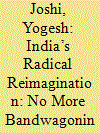

|
|
|
|
|
| Summary/Abstract |
In 2020, following the deadliest border crisis with China in over 45 years on the Himalayan frontier in the Galwan valley, India’s External Affairs Minister S. Jaishankar clarified that “we were never part of an alliance and will not be.”Footnote1 Aversion to alliances notwithstanding, there is more than one way to balance China’s rise, and India has recently decided that it needs to. Indian media often attributes Beijing’s increasing aggressiveness to the shifts in Sino-Indian balance of power: “the balance of power has shifted against us and so, China’s behaviour has changed too.”Footnote2 New Delhi’s approach to restoring the balance is to build a strategic partnership with the United States, and to reinforce the global balance of power in favor of the US. As former Indian Foreign Secretary and former Ambassador to China Vijay Gokhale opined in The New York Times in 2020, “The world needs balance—at the moment, no country other than the United States has the means to ensure it. At a practical level, its leadership is indispensable.”Footnote
|
|
|
|
|
|
|
|
|
|
|
|
|
|
|
|
| 7 |
ID:
190367
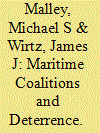

|
|
|
|
|
| Summary/Abstract |
When Bernard Brodie wrote his Guide to Naval Strategy in the early days of the Second World War, he emphasized that US naval operations in the Pacific had to secure bases close to the theater of operations around Japan in order to repair ships, resupply forces, and shift troops to a combat footing after traveling thousands of miles from the West Coast or even Hawaii.Footnote1 Today’s maritime strategists are in a better position when it comes to deterrence in the region. America’s friends and allies across the Indo-Pacific can provide US forces with facilities in peacetime, at the outset of a crisis, or during war.
|
|
|
|
|
|
|
|
|
|
|
|
|
|
|
|
| 8 |
ID:
190364
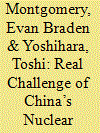

|
|
|
|
|
| Summary/Abstract |
For more than a decade, China’s military modernization has cast a shadow across the Indo-Pacific. For instance, the People’s Liberation Army (PLA) has fielded a variety of missiles and aircraft that have heightened the vulnerability of the United States, its allies, and its partners to conventional precision strikes. Moreover, an expanding fleet of surface vessels, amphibious platforms, and submarines could eventually provide Beijing with the ability to seize territory it covets and sustain military operations far beyond its neighborhood. These and other investments have not only raised questions about Washington’s ability to deter the use of force against frontline states, but also created doubts whether the United States could defeat an assault if deterrence were to fail.Footnote
|
|
|
|
|
|
|
|
|
|
|
|
|
|
|
|
| 9 |
ID:
190366
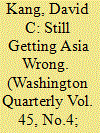

|
|
|
|
|
| Summary/Abstract |
Is there an incipient East Asian containment coalition against China? Evidence leads to the conclusion that there is not. Yet for almost three decades, scholars have been claiming that the rapid growth of Chinese power is, will or should cause East Asian countries to balance against it and join a US-led containment coalition. Those claiming that East Asian states are already containing China include political scientist Michael Beckley, who writes that “China’s neighbors are arming themselves and aligning with outside powers to secure their territory and sea-lanes. Many of the world’s largest economies are collectively developing new trade, investment, and technology standards that implicitly discriminate against China.”Footnote1 In 2014, scholars Adam Liff and John Ikenberry claimed that “there is already some evidence of security dilemma-driven military competition in the Asia Pacific, which could worsen significantly in the near future … [S]ecurity dilemma dynamics appear to be important drivers of states enhancing military capabilities in the increasingly volatile Asia Pacific region.”
|
|
|
|
|
|
|
|
|
|
|
|
|
|
|
|
|
|
|
|
|